It’s been a couple of weeks since the last post in The Bread & Soup Project, one week spending my days off in Uruguay, and the other, fighting off a bit of a cold. I told you this was going to take a few years to work through all the countries!
 Next up in the alphabetical list, Antigua & Barbuda, a duo (inhabited) of Caribbean isles with a strong British background. There are also a number of smaller islands, for the most part uninhabited or close to it, that form part of the nation. The cuisine certainly has some British influences, but, like many of the island states in the area, it has a strong influence that stems from the slavery era, via Guyana, and much of the cuisine here, in Trinidad, Nevis, and Guyana itself, tends to be pretty similar.
Next up in the alphabetical list, Antigua & Barbuda, a duo (inhabited) of Caribbean isles with a strong British background. There are also a number of smaller islands, for the most part uninhabited or close to it, that form part of the nation. The cuisine certainly has some British influences, but, like many of the island states in the area, it has a strong influence that stems from the slavery era, via Guyana, and much of the cuisine here, in Trinidad, Nevis, and Guyana itself, tends to be pretty similar.
Off the bat it seemed pretty clear that Pepperpot is generally considered the national soup. It also is in several other countries in the Caribbean, which will make for some interesting decisions down the line. Other soups considered: Souse, which is basically a ceviche of pig’s trotters and cheeks, which in Antigua is made into a more soupy version than in most other locales, but in the end, it’s not really a soup, it’s a pork ceviche with water added; various black bean and lentil soups were possibilities, but none of them stood out as being at all different from black bean and lentil soups in many parts of the world, and certainly wouldn’t be considered a national dish; and conch or other seafood chowder, much like the Anguillan one I made in the last entry. So, pepperpot.
The filled bread became the major issue, and I finally just decided to not go with a filled one, but just what seems to be the most ubiquitous bread on the island, Roti. Yes, it’s often filled with or served with a curry of one sort or another, and I considered that, but essentially, when done that way, it’s a main course on its own, and would have not really been an accompaniment to the soup. So, sometimes you have to bend with the way the wind blows. Plain roti it would be.
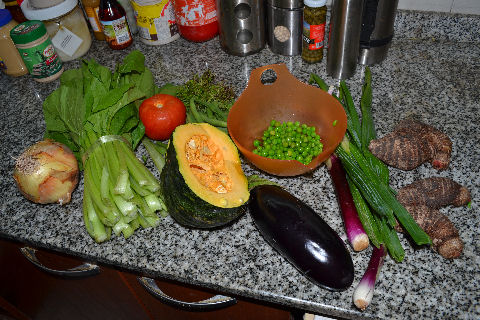 The vegetables, which I’ll get to in the photos below. The meat became an issue. There are numerous versions of pepperpot, and in the end, it came down to, for me, using a trio – pig’s trotter, salt beef, and salt pork. Here’s the rub. We don’t have salt beef or salt pork here – every now and again I’ve seen something similar to salt pork, but it’s just not the same. And for the beef, in modern days, corned beef seems to be the type of salt beef chosen, though from what reading I’ve done, I’d say that the more traditional would be what the British would have called naval beef – the biggest difference between the two is that naval beef is brined fairly straightforwardly – salt, pepper, and some garlic, while corned beef adds a range of pickling spices to the brine. I ended up making my own – following, more or less, a “quick” procedure that I found online – brining some brisket, some pork breast, and while I was at it, a split pig’s trotter as well, overnight, and then pressure cooking them together for about an hour in the brine. Then I cooled them, and shredded them (meat and some of the trotter skin and fat) to add to the soup. I chilled the cooking liquid, skimmed the fat, and used the liquid as part of the soup broth.
The vegetables, which I’ll get to in the photos below. The meat became an issue. There are numerous versions of pepperpot, and in the end, it came down to, for me, using a trio – pig’s trotter, salt beef, and salt pork. Here’s the rub. We don’t have salt beef or salt pork here – every now and again I’ve seen something similar to salt pork, but it’s just not the same. And for the beef, in modern days, corned beef seems to be the type of salt beef chosen, though from what reading I’ve done, I’d say that the more traditional would be what the British would have called naval beef – the biggest difference between the two is that naval beef is brined fairly straightforwardly – salt, pepper, and some garlic, while corned beef adds a range of pickling spices to the brine. I ended up making my own – following, more or less, a “quick” procedure that I found online – brining some brisket, some pork breast, and while I was at it, a split pig’s trotter as well, overnight, and then pressure cooking them together for about an hour in the brine. Then I cooled them, and shredded them (meat and some of the trotter skin and fat) to add to the soup. I chilled the cooking liquid, skimmed the fat, and used the liquid as part of the soup broth.
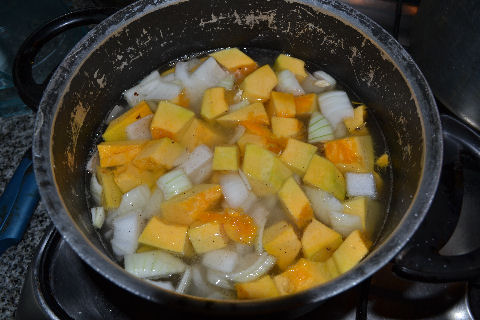 Lightly sautéed chopped onion and chilies in a little oil until soft, then added the pumpkin and taro root, cooking for about five minutes.
Lightly sautéed chopped onion and chilies in a little oil until soft, then added the pumpkin and taro root, cooking for about five minutes.
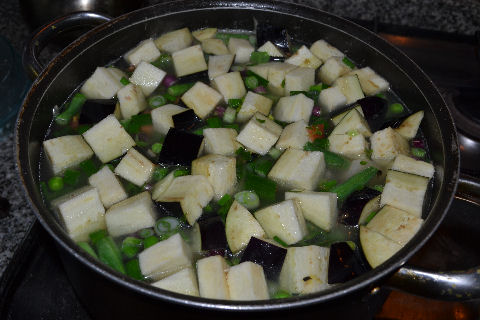 Added in diced eggplant, green beans (it should be okra, but it’s not in season), peas (some folk use pigeon peas, some green, I don’t have access to the former, so, I used green), tomato, green onions, and thyme. Topped up with the meat cooking liquid and enough extra water to cover all the vegetables. Simmered until the harder vegetables were soft.
Added in diced eggplant, green beans (it should be okra, but it’s not in season), peas (some folk use pigeon peas, some green, I don’t have access to the former, so, I used green), tomato, green onions, and thyme. Topped up with the meat cooking liquid and enough extra water to cover all the vegetables. Simmered until the harder vegetables were soft.
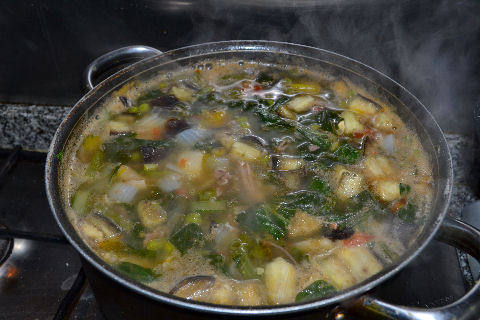 Add the shredded meat and some chopped Chinese mustard cabbage – what I wanted was amaranth leaves, which would be the traditional, but no one in barrio chino had them, nor did anyone have any water spinach, a common substitute. Both usually available, so disappointing. So be it. Salt and black pepper to taste.
Add the shredded meat and some chopped Chinese mustard cabbage – what I wanted was amaranth leaves, which would be the traditional, but no one in barrio chino had them, nor did anyone have any water spinach, a common substitute. Both usually available, so disappointing. So be it. Salt and black pepper to taste.
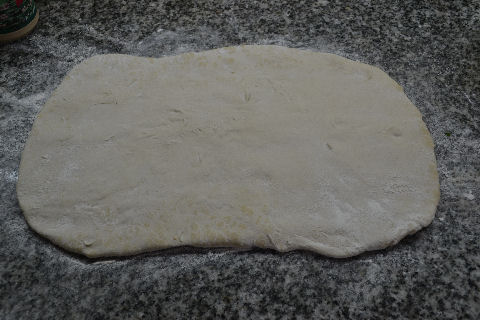 A simple, soft dough of 220gm bread flour, ¼tsp salt, ½tsp baking powder, ¼tsp baking soda, and 220ml warm water, kneaded, left to sit, and then rolled out into a rectangle about 1/8″ thick.
A simple, soft dough of 220gm bread flour, ¼tsp salt, ½tsp baking powder, ¼tsp baking soda, and 220ml warm water, kneaded, left to sit, and then rolled out into a rectangle about 1/8″ thick.
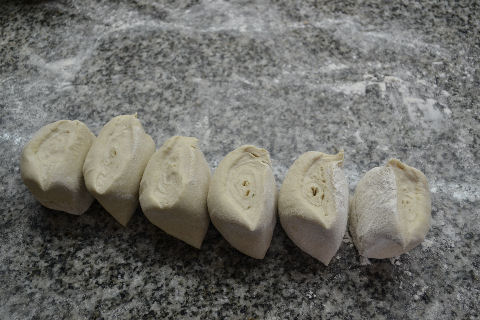 …sliced into six equal spirals, kind of like a cinnamon roll. Now, everything I’ve read about making roti says that the rings from the spiral should stay visible when you roll them out, but these didn’t – after the dough sat for about another 15 minutes, it all kind of melded together. Something to research.
…sliced into six equal spirals, kind of like a cinnamon roll. Now, everything I’ve read about making roti says that the rings from the spiral should stay visible when you roll them out, but these didn’t – after the dough sat for about another 15 minutes, it all kind of melded together. Something to research.
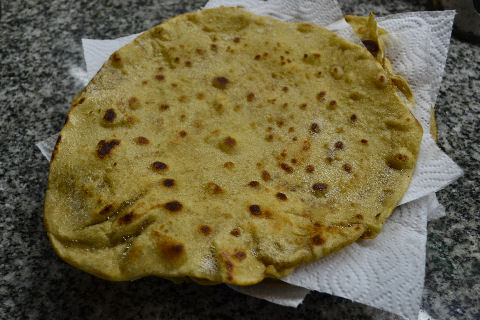 Rolled out into large circles, dry griddled first to lightly toast both sides, then brushed with a mix of oil and shortening, and finished browning both sides. Folded up to serve.
Rolled out into large circles, dry griddled first to lightly toast both sides, then brushed with a mix of oil and shortening, and finished browning both sides. Folded up to serve.
Overall, we liked both, and Henry particularly liked the roti, but not a soup we’d likely make again, or at least not the same way – maybe more like the version below…. Next round – Argentina – that should be relatively easy.
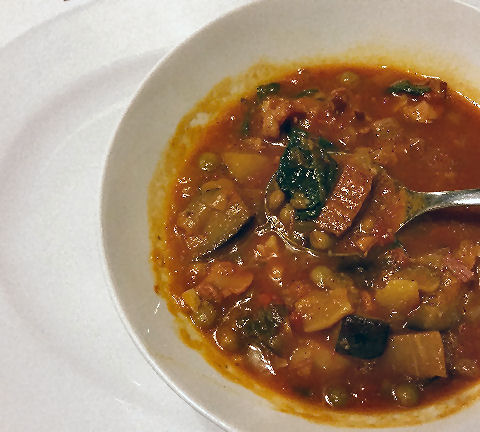
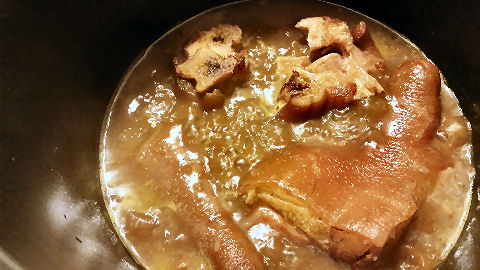
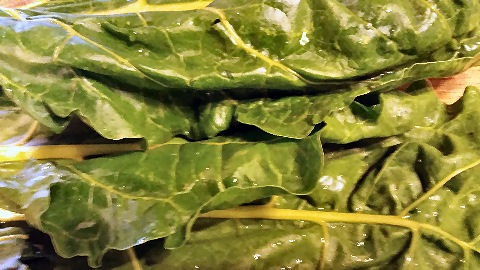 The most popular soup from Antigua is probably Pepperpot with some suggesting an otherwise pig’s foot soupy ceviche known as Souse.
The most popular soup from Antigua is probably Pepperpot with some suggesting an otherwise pig’s foot soupy ceviche known as Souse.
What is attractive to me about Pepperpot is working with smoked pig parts to flavor the soul of your soup! I was excited about the smoked offal so I used equal portions of smoked hock and tail, and combined with a pound of cubed corned beef boiled, then simmered in beef broth and water for an hour and a half, or until coming off the bone. I pulled out the strainer and kept the au jus, and started the aromatics – garlic, green onion, onion, scotch bonnet peppers. Pepperpot turns out to be a range of delicious vegetables within a porky base that screams for fire, so use as much scotch bonnet as you like. Keep in mind, 3 deseeded jalapeños equals one deseeded scotch bonnet.
After the foundation was built I opted to go with a version that includes tomatoes. Some even say ketchup. I added strained peeled tomatoes and 1/4 cup tomato paste which was cooked down with thyme, for about 20 minutes, add chive if you have it. I added 3 cubed potatoes and one small eggplant until they were well touched by heat and prepped for the cooking liquid.
So in goes the broth and all the meat I could find from the pork, as well as some of the fat. I think most people remove the hocks where as I ripped them apart and found porky gems that I first taste approved, of course, and added to what is the last 20-30 minutes of cooking. With the broth and meat together with the eggplant and potato, everything cooked al dente I add what I think is a great part of the soup, Pigeon Peas and greens, I used Chard.
Cooked for a few more minutes and season with your own Scotch Bonnet fire. It was the first time braising smoked parts and I understand why it’s loved throughout the Caribbean. Next stop, Argentina. I’m already here.
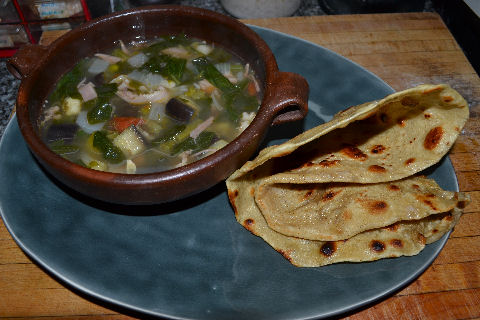

[…] time, Antigua & Barbuda. Predictable, I […]